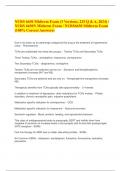NURS 6630 Midterm Exam (3 Versions, 225 Q & A, 2024) /
NURS 6630N Midterm Exam / NURS6630 Midterm Exam
(100% Correct Answers)
Due to its action as an adrenergic antagonist this drug is the treatment of hypertensive
crisis: - Phentolamine
TCAs are subdivided into these two groups: - Tertiary TCAs and Secondary TCAs
Three Tertiary TCAs: - amitriptyline, imipramine, clomipramine
Two Secondary TCAs: - desipramine, nortriptyline
Tertiary TCAs are non-selective and act on: - Serotonin and Norephinephrine
transporters (increase 5HT and NE)
Secondary TCAs are selective and act only on: - Norepinephrine transporters (increase
NE)
Therapeutic benefits from TCAs typically take approximately: - 2-4 weeks
In addition to treatment of depression, other indications for TCAs include: - Phobic
disorders, chronic neuropathic pain, migraine prophylaxis
Medication specific indication for clomipramine: - OCD
Medication specific indication for imipramine: - Nocturnal enuresis
Serotonin regulates - Mood, emotion, feeding, and reproductive behavior
This class of antidepressants binds to presynaptic SERT and inhibits them from
reuptake of serotonin to increase levels in the synaptic cleft to bind with postsysnaptic
5HT2 receptors - SSRIs
First line therapy for MDD due to milder side effect profiles - SSRIs
Six Common SSRIs - citalopram, escitalopram, fluoxetine, fluvoxamine, sertraline,
paroxetine
, Onset of therapeutic benefit from SSRIs - 4-6 weeks
In addition to MDD, SSRIs also treat - Chronic Anxiety, PTSD, OCD, and eating
disorders (bulimia)
Five Common side effects of SSRIs include - Anxiety, insomnia, GI distress, sexual
dysfunction (ED), SIADH
Severe side effect of SSRIs in children/adolescents under age 25 years old - suicidal
ideation
Life threatening adverse effect of SSRIs, especially when used in combination with
other serotonergic drugs (SNRIs, TCAs, MAOIs, etc.) - Serotonin Syndrome
All SSRIs but paroxetine (D) are pregnancy category - C
Three SSRIs that are inhibitors of Cytochrome P450 enzymes - fluoxetine, fluvoxamine,
and paroxetine
Five common SNRIs include - duloxetine, venlafaxine, desvenlafaxine, milnacipran,
levomilnacipran
This antidepressant class of medications works by binding to presynaptic SERT and
NET to inhibit them from reuptake of serotonin and norepinephrine to increase their
levels in the synaptic cleft - SNRIs
In addition to MDD SNRIs treat - Anxiety and neuropathic pain (peripheral neuropathy)
Medication specific indications of duloxetine: - urinary incontinence and Fibromyalgia
Medication specific indications of venlafaxine: - social anxiety, panic disorders, PTSD,
OCD, postmenopausal hot flashes
Six common side effects of SNRIs include: - Insomnia, nausea, sexual dysfunction,
hypertension, sweating, headaches
Severe side effect of SNRIs in children/adolescents under age 25 years old: - suicidal
ideation
Life threatening adverse effect of SNRIs, especially when used in combination with
other serotonergic drugs: - Serotonin Syndrome




